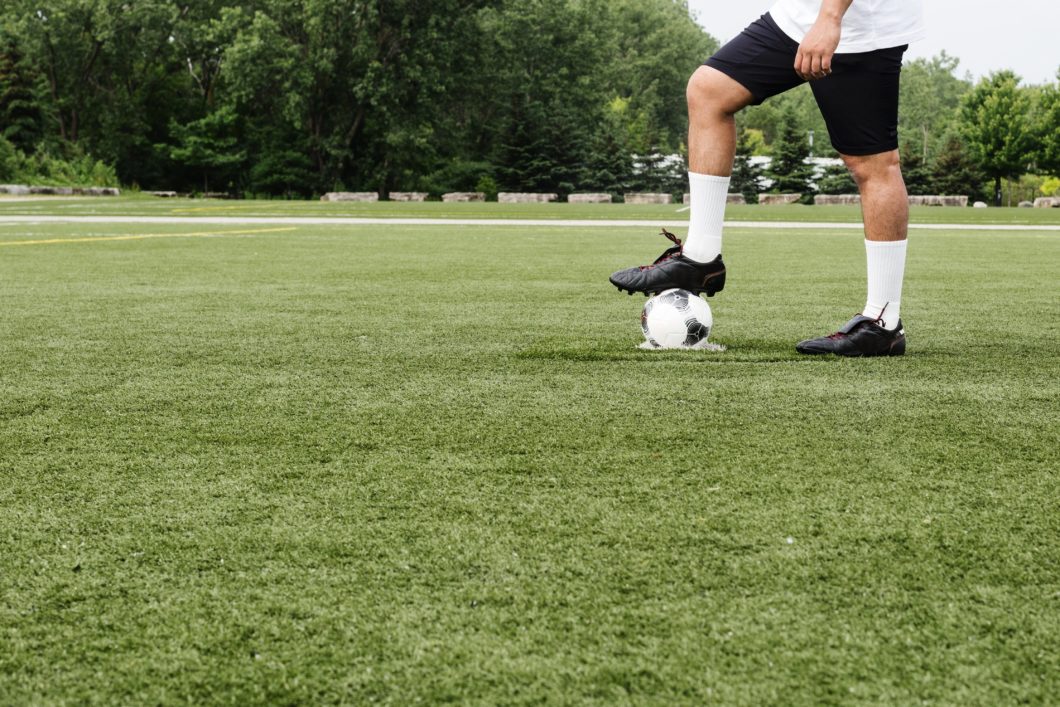
Each soccer player has their favourite game conditions. Many enjoy a beautiful summer day, others love sliding over wet grass as the rain pours down. Epic moments can lead to epic injuries. Whether displaying some fancy footwork or pushing harder to beat the opponent, there are some common injuries that can lead to some serious bench time.
The top four soccer injuries include:
- Lateral ankle sprain
- ACL (knee) sprain
- Groin strain (pulled groin)
- Hamstring strain (pulled hamstring)
Most common injuries soccer players endure are usually non-contact. Meaning, the player has a hand in their fate. Strength, endurance and flexibility each have an important role for every athlete. Therefore, preventative strategies and techniques can help minimize the risk of injury (1).
LATERAL ANKLE SPRAIN
Lateral ligament injuries are about one of the most common sports-related injuries. For a more in-depth understanding of lateral ankle sprains, you can visit this blog.
If athletes seek proper physical attention from one of our physiotherapists, osteopaths, or RMTs on staff, this would be considered as a benign injury and would last around 6 weeks. However, if athletes continue to play on the injury or have inadequate rehabilitation, it can lead to residual symptoms which can last up to 18 months! Further complications can manifest this simple sprain into sprained ankle syndrome (2). Athletes who suffer continuous ankle sprains have reported weakened stability and an increased likelihood of re-injury. Seeking medical attention from one of our practitioners is always a wise choice. They can advise you on a treatment plan, or if the injury is more serious.
ACL SPRAIN
As devastating and violent ACL injuries are, a significant portion are non-contact (3). Meaning, they are often caused by faulty movement mechanics due to muscular imbalances rather than a physical blow to the knee caused by an external force. Therefore, seeking weekly treatment with our therapists can help reduce the risk of injury. For example, osteopaths are masters at finding the imbalances within, and maneuvering the body back into alignment.
However, if injury occurs, osteopaths can work to rehabilitate the damaged ACL. Osteopaths will encourage range of motion in both flexion and extension, then slowing allow weight on the injured knee. Our osteopaths aim to eliminate any limp and restore walking ability as soon as possible (4). Osteopaths are great when patients seek a gentle manual treatment plan. Physiotherapy can also be considered for this injury. Treatment can include mobilization, ultrasound and electrotherapy. A consultation can help you create a treatment plan specific to you.
GROIN STRAIN
Explosive movements like kicking, pivoting, sliding, or tackling that soccer requires makes soccer players more susceptible groin injuries. It is a nagging injury that can bench players for a season, or cause them to underperform.
Getting limber before the game is important, but if unchecked stretching could lead to a groin injury. Excessive stretching may tear the muscles in the groin region called your adductors. To prevent this, dynamic stretching to start your warmup is key. These movements help prepare groin muscles for the explosive movements during play. The cool down is just as essential as the warm up. Any hip opener is recommended to stretch that region.
Groin injuries typically occur from overuse instead of solely weakness. Common reasons we overuse our groin muscles can include poor core strength, gluteal strength, and hamstring strength. An initial assessment from a physiotherapist can help create a unique treatment plan for your range of motion (5).
HAMSTRING STRAIN
If you are a soccer player, chances are you suffered from some degree of hamstring strain. Re-injuries are common with this strain, but there are preventative measures athletes can do. An appointment with a physiotherapist can help assess the degree of your injury and provide a treatment plan specific to you.
Major risk factors of a hamstring strain include muscle imbalances. This can include the quadriceps (the muscle on top of the thigh) being stronger than the hamstrings and glutes, and poor flexibility (6). Call today to book an initial assessment, and have a physiotherapist assess your range of motion to determine the best treatment plan for you.
RELAX
There is nothing like a nice post-tournament massage to relax your stiff muscles. A deep tissue massage from one of our RMTs can relax the muscles, and help you get back to the field faster. Playing stiff can likely lead to injury, therefore any preventive measures are important.
INJURY PREVENTION
The goal of injury prevention is to increase the tissue load capacity with progressive stress. This concept is similar to muscle building versus weight training. A registered physiotherapist can suggest types of stretches and warmups to do before play as a preventative measure.
Call today to book an appointment, and speak with one of our helpful practitioners!